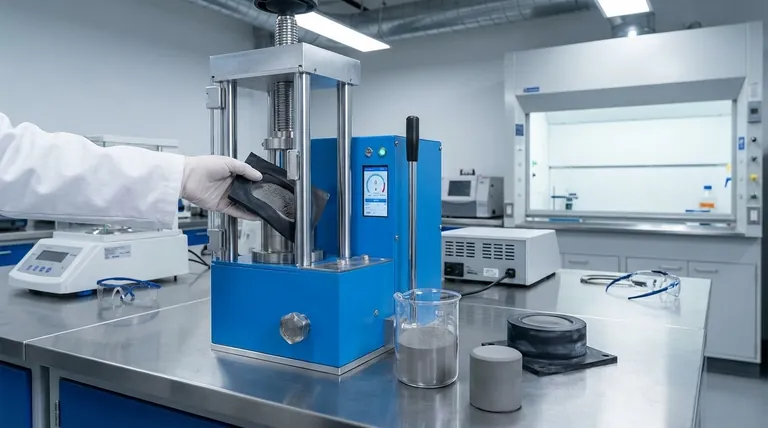본질적으로 냉간 등방압 성형(CIP)은 고압 유체를 사용하여 분말을 고체 형태로 균일하게 압축하는 제조 공정입니다. 이 공정은 상온 또는 상온에 가까운 온도에서 작동하며, 모든 방향에서 압력을 균등하게 가하여 밀도가 높고 응집된 구성 요소인 "그린 컴팩트"를 생성하며, 이는 추가 공정을 위한 준비가 된 상태입니다.
분말이 채워진 유연한 몰드를 액체에 넣고 전체 챔버에 압력을 가함으로써, 냉간 등방압 성형은 유체 역학을 활용하여 전통적인 기계적 압축의 한계를 극복하고, 우수한 밀도와 균일성을 가진 부품을 생산합니다.
냉간 등방압 성형 작동 방식
CIP를 이해하려면 그 기본 원리와 실제 실행을 모두 파악하는 것이 중요합니다. 이 방법은 우아한 단순성과 매우 효과적인 결과로 가치가 높습니다.
핵심 원리: 파스칼의 법칙
이 공정은 파스칼의 법칙에 따라 작동합니다. 파스칼의 법칙은 밀폐된 유체에 가해진 압력은 유체의 모든 부분과 용기의 벽에 감소 없이 전달된다고 명시합니다.
쉬운 비유는 깊은 물속에 잠긴 물체입니다. 물체가 경험하는 압력은 위에서뿐만 아니라 모든 면에서 균등하게 가해집니다. CIP는 통제된 산업 환경에서 이 정확한 원리를 활용합니다.
단계별 공정
- 분말 재료는 먼저 유연한 탄성 몰드(고무 또는 우레탄과 같은)에 넣어집니다. 이 몰드는 최종 부품의 모양을 정의합니다.
- 몰드는 압축을 방해할 수 있는 갇힌 공기를 제거하기 위해 종종 진공 상태에서 밀봉됩니다.
- 밀봉된 몰드는 작동 유체(일반적으로 부식 억제제가 포함된 물, 오일 또는 글리콜 혼합물)로 채워진 압력 챔버에 잠기게 됩니다.
- 외부 펌프가 이 유체에 압력을 가하며, 압력은 20에서 400 MPa에 이릅니다. 이 엄청난 압력은 유연한 몰드의 전체 표면에 균일하게 가해집니다.
- 몰드 내부의 분말은 고체, 응집성 덩어리로 압축됩니다. 이 결과물은 "그린 컴팩트" 또는 "그린 바디"라고 불리는데, 이는 취급 강도는 있지만 최종 가열 공정을 통해 완전히 강화되지 않았기 때문입니다.

CIP 사용의 주요 장점
균일한 압력 적용은 CIP에 기존의 단축(일방향) 압축 방법보다 몇 가지 뚜렷한 장점을 제공합니다.
비교할 수 없는 밀도 균일성
압력이 모든 방향에서 동시에 가해지기 때문에 CIP는 한두 방향에서만 압축할 때 발생할 수 있는 밀도 변화와 내부 응력 지점을 제거합니다. 이는 매우 균일한 그린 컴팩트를 생성합니다.
복잡하고 큰 부품 성형
단단한 금속 다이는 비교적 단순한 모양만 성형할 수 있습니다. 유연한 몰드와 유체 압력을 사용하면 다른 방법으로는 생산 불가능한 복잡하고 정교한 형상과 매우 큰 부품을 만들 수 있습니다.
어려운 재료 가공
경질 금속, 탄화물, 특정 세라믹과 같은 많은 첨단 재료는 전통적인 방법으로는 효과적으로 압축하기가 매우 어렵습니다. CIP는 이러한 까다로운 분말을 성공적으로 압축하는 데 필요한 힘과 균일성을 제공합니다.
향상된 최종 소결 결과
그린 컴팩트의 높고 균일한 밀도는 최종 소결(고온 소성) 단계에서 수축이 적고 더 예측 가능하게 일어난다는 것을 의미합니다. 이는 더 나은 치수 정확도와 완성된 부품의 낮은 불량률로 이어집니다.
트레이드오프 및 맥락 이해
강력하지만 CIP는 원스텝 솔루션이 아닙니다. 이는 더 큰 제조 워크플로우 내에서 특정 목적을 위해 사용되는 특정 도구입니다.
중간 단계입니다.
CIP가 완성된 제품이 아닌 그린 컴팩트를 생산한다는 점을 이해하는 것이 중요합니다. 이 부품은 취급 및 가공할 수 있을 만큼의 강도를 가지고 있지만, 분말 입자를 융합하고 최종 기계적 특성 및 밀도를 얻기 위해서는 소결과 같은 후속 열처리가 필요합니다.
냉간 등방압 성형(CIP) vs. 열간 등방압 성형(HIP)
CIP는 종종 고온 공정인 열간 등방압 성형(HIP)과 혼동됩니다.
- 냉간 등방압 성형(CIP): 상온에서 분말로부터 균일한 그린 컴팩트를 생성하는 데 사용됩니다. 주요 목표는 최종 소결 전에 성형 및 균일한 밀도를 달성하는 것입니다.
- 열간 등방압 성형(HIP): 고온에서 부품을 완전히 밀집시키고, 주조품의 내부 기공을 닫거나, 이종 재료를 접합하는 데 사용됩니다. 이는 종종 최종 또는 거의 최종 제조 단계입니다.
장비 및 공정 고려 사항
이 공정은 심하고 반복적인 고압 사이클을 견딜 수 있도록 설계된 특수 압력 용기가 필요합니다. 워크플로우는 분말 준비, 몰딩, 압축, 소결 등 여러 단계로 구성되며, 이를 효과적으로 관리해야 합니다.
냉간 등방압 성형을 고려해야 할 때
CIP 사용 여부는 재료, 부품의 복잡성, 최종 제품의 원하는 품질에 전적으로 달려 있습니다.
- 복잡한 형상을 균일한 밀도로 생산하는 것이 주요 목표라면: CIP는 유체 압력이 모든 형상에 적합하여 단축 압축에서 흔히 발생하는 약점과 밀도 구배를 제거하므로 이상적입니다.
- 탄화물 또는 세라믹과 같이 압축하기 어려운 분말을 다루는 것이 주요 목표라면: CIP를 사용하여 이러한 까다로운 재료로부터 실행 가능한 그린 컴팩트를 만드는 데 필요한 엄청나고 균일한 힘을 제공하십시오.
- 최종 소결 중 변형을 최소화하고 치수 제어를 개선하는 것이 주요 목표라면: CIP로 생산된 그린 부품으로 시작하십시오. 탁월한 균일성은 소성 후 더 예측 가능하고 일관된 결과를 가져옵니다.
궁극적으로 냉간 등방압 성형은 고품질의 균일한 분말 압축체를 만드는 강력한 도구이며, 이는 후속 제조 작업의 우수한 기반이 됩니다.
요약 표:
| 주요 측면 | 세부 사항 |
|---|---|
| 공정 | 고압 유체를 사용하여 상온에서 분말 압축 |
| 원리 | 파스칼의 법칙 - 모든 방향에서 균일한 압력 |
| 결과물 | 소결 준비가 된 '그린 컴팩트' |
| 주요 장점 | 비교할 수 없는 밀도 균일성 및 복잡한 형상 성형 능력 |
| 이상적인 적용 분야 | 세라믹, 탄화물과 같이 압축하기 어려운 재료 및 복잡한 부품 |
우수한 균일성을 가진 복잡하고 고밀도 부품을 생산할 준비가 되셨습니까?
KINTEK은 실험실 장비 및 소모품을 전문으로 하며, 모든 분말 가공 요구 사항에 대한 솔루션을 제공합니다. 등방압 성형 기술에 대한 당사의 전문 지식은 가장 까다로운 재료와 형상에 대해서도 일관된 결과를 얻을 수 있도록 도와드릴 수 있습니다.
오늘 저희 전문가에게 문의하십시오 당사의 장비가 귀하의 실험실 역량을 강화하고 제조 공정을 간소화하는 방법에 대해 논의하십시오.
시각적 가이드

관련 제품
- 수동 등압 성형기 CIP 펠렛 프레스
- 전기 실험실 냉간 등압 프레스 CIP 기계
- 자동 실험실 냉간 등압 프레스 CIP 장비 냉간 등압 성형
- 단일 펀치 전기 타블렛 프레스 기계 실험실 분말 타블렛 펀칭 TDP 타블렛 프레스
- 샘플 준비용 진공 냉간 마운팅 머신



















